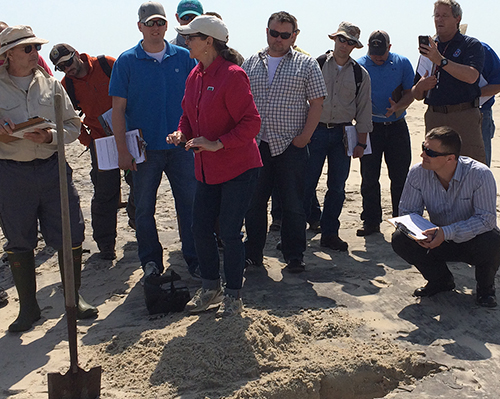SCAT Class Held at Assateague National Seashore, Virginia
APRIL 30, 2015 -- U.S. Coast Guard District 5 and OR&R’s Emergency Response Division co-hosted a three-day Shoreline Cleanup Assessment Technique (SCAT) class that took place at the Assateague National Seashore, Virginia from April 19-21, 2015.

The students in the class came from the USCG, including Headquarters, District 5, Sectors Delaware Bay, Baltimore, Hampton Roads and North Carolina as well as from Virginia Department of Emergency Management, Virginia Department of Environmental Quality, U.S. Fish and Wildlife Service, and The Nature Conservancy. In addition to SCAT training, the students participated in a presentation from Kevin Holcomb, a Supervisory Biologist for the Chincoteague National Wildlife Refuge, on refuge management and local ecological resources.
SCAT is a systematic method for surveying an affected shoreline after an oil spill. The SCAT method originated during the response to the 1989 Exxon Valdez oil spill, when responders needed a systematic way to document the spill's impacts on many miles of affected shoreline. The SCAT approach uses standardized terminology to document shoreline oiling conditions. SCAT is designed to support decision-making for shoreline cleanup. It is flexible in its scale of surveys and in the detail of data sets collected. SCAT is a regular part of the oil spill response. SCAT surveys begin early in the response to assess initial shoreline conditions, and ideally continue to work in advance of operational cleanup.
Despite its relatively small size of less than 18,000 acres, a surprising array of habitats and natural features can be found on Assateague Island. From beach to bay, Assateague Island holds a wealth of habitats and natural features. Forests, marshes, beaches, shrub lands, grasslands, and dunes, can all be found within the Seashore’s boundaries. This is also where the famous wild ponies wander the beaches, inland pine forest and salt marshes.
In addition to the classroom lectures and exercises, the instructors and students conducted field trips to nearby ocean front beaches, bay shorelines and nearby wetland areas so that the students could experience the wide diversity of coastal marine resources and get hands-on shoreline assessment training.
For additional information, contact Frank.Csulak@noaa.gov.
Go back to OR&R Weekly Report.
